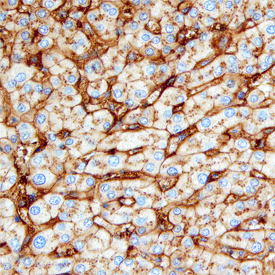Human Hemopexin Antibody Summary
Thr24-His462
Accession # P02790
Applications
Please Note: Optimal dilutions should be determined by each laboratory for each application. General Protocols are available in the Technical Information section on our website.
Scientific Data
 View Larger
View Larger
Hemopexin in Human Liver. Hemopexin was detected in immersion fixed paraffin-embedded sections of human liver using Sheep Anti-Human Hemopexin Antigen Affinity-purified Polyclonal Antibody (Catalog # AF4490) at 3 µg/mL overnight at 4 °C. Before incubation with the primary antibody, tissue was subjected to heat-induced epitope retrieval using Antigen Retrieval Reagent-Basic (Catalog # CTS013). Tissue was stained using the Anti-Sheep HRP-DAB Cell & Tissue Staining Kit (brown; Catalog # CTS019) and counter-stained with hematoxylin (blue). Specific staining was localized to bile canaliculi. View our protocol for Chromogenic IHC Staining of Paraffin-embedded Tissue Sections.
Reconstitution Calculator
Preparation and Storage
- 12 months from date of receipt, -20 to -70 °C as supplied.
- 1 month, 2 to 8 °C under sterile conditions after reconstitution.
- 6 months, -20 to -70 °C under sterile conditions after reconstitution.
Background: Hemopexin
Hemopexin (HPX) is a 60 kDa plasma glycoprotein with two four-bladed beta -propeller folds. This structural motif has been found in other proteins including collagenases and provides sites for protein-protein interactions (1‑3). The liver is the major synthesizing organ. Expression in the central nervous system, in the retina, and in peripheral nerves has also been observed. Hemopexin belongs to the family of the acute-phase proteins whose synthesis is induced after an inflammatory event. Hemopexin participates in maintaining and recycling the iron pool by utilizing its high binding affinity toward heme composed of protoporphyrin IX and iron. It also functions in preventing oxidation caused by heme after hemolysis. Hydrophobic heme molecules can intercalate into lipid membranes and participate in the oxidation of lipid membrane components through the Fenton reaction resulting in lipid peroxidation. Hemopexin undergoes a conformational change upon the binding of heme. The conformational change allows hemopexin to interact with a specific receptor, forming a complex which is then internalized. In the plasma, it is likely that heme binds albumin (35‑55 g/L) first because of the higher concentration of albumin in plasma than hemopexin (0.5‑1.2 g/L), and is then transferred to hemopexin, which has a much higher affinity (Kd ~ 1 pM) toward heme. Heme concentrations in plasma increase after hemolysis, which is associated with several pathological conditions such as reperfusion injury and ischemia.
Product Datasheets
FAQs
No product specific FAQs exist for this product, however you may
View all Antibody FAQsReviews for Human Hemopexin Antibody
There are currently no reviews for this product. Be the first to review Human Hemopexin Antibody and earn rewards!
Have you used Human Hemopexin Antibody?
Submit a review and receive an Amazon gift card.
$25/€18/£15/$25CAN/¥75 Yuan/¥1250 Yen for a review with an image
$10/€7/£6/$10 CAD/¥70 Yuan/¥1110 Yen for a review without an image

